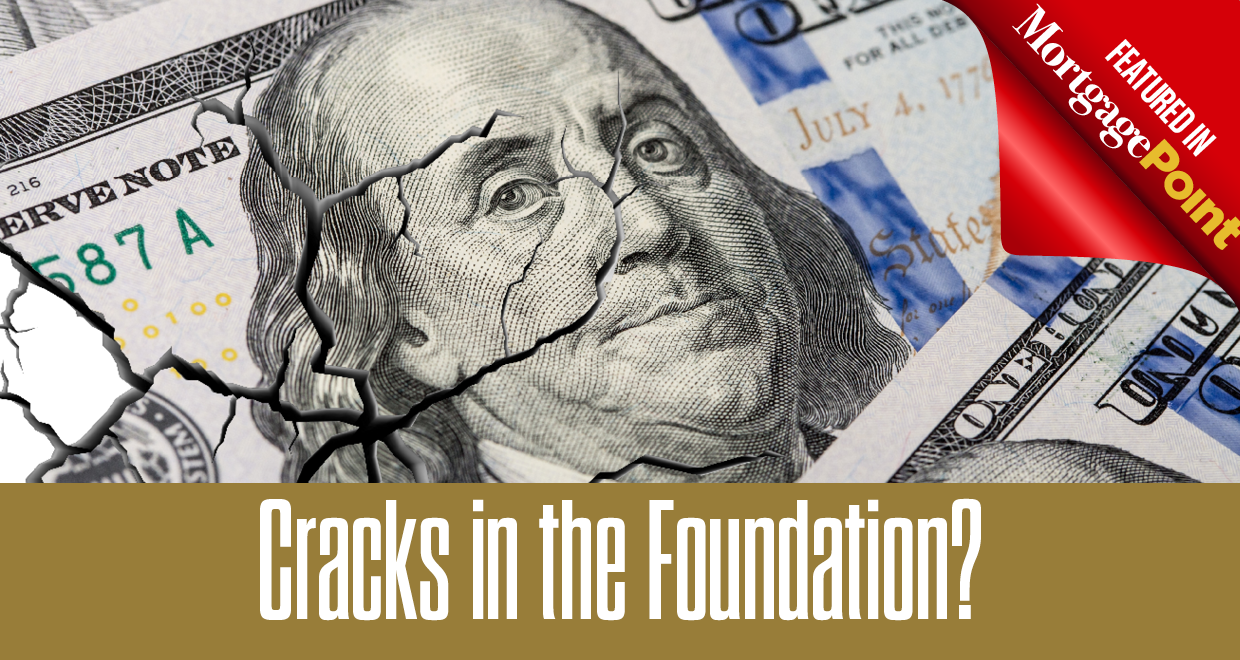
This piece originally appeared in the May 2023 edition of MortgagePoint magazine, online now.
Earlier this year, Silicon Valley Bank (SVB) customers pulled $42 billion out of its institution—fueled by venture capitalists and their social media accounts—creating one of the largest and fastest bank runs in history.
Closed by the California Department of Financial Protection and Innovation, which appointed the Federal Deposit Insurance Corporation (FDIC) as receiver, SVB had 17 branches in California and Massachusetts. As of December 31, 2022, SVB reportedly had approximately $209 billion in total assets and nearly $175.4 billion in total deposits.
Just days later, Signature Bank was closed by the New York State Department of Financial Services, which also appointed the FDIC as receiver. To protect depositors, the FDIC transferred all the deposits and substantially all of the assets of Signature Bank to Signature Bridge Bank, NA, a full-service bank operated by the FDIC as it marketed the institution to potential bidders. At the time of its closing, Signature Bank had 40 branches across the country in New York, California, Connecticut, North Carolina, and Nevada, and reported total assets of $110.4 billion and total deposits of $88.6 billion as of December 31, 2022.
For those who lived through the time of the financial crisis of 2007-2008, the vibe in early March of 2023 couldn’t help but evoke a dark chapter in the mortgage industry: memories of a time when the headlines were filled with the names of now-defunct bad actors such as Ameriquest, New Century, and Countrywide.
Lessons learned from that era were carried throughout the next decade-plus, as tighter underwriting standards and greater banking oversight became the new norm, with the microscope laser-focused on the banking space to prevent history from repeating itself.
“Silicon Valley Bank almost quadrupled in size over three years, and Signature Bank more than doubled in that time,” said Sen. Sherrod Brown, Chairman of the U.S. Senate Committee on Banking, Housing, and Urban Affairs, during a recent Committee Hearing titled Recent Bank Failures and the Federal Regulatory Response.
“The principles here are not complicated,” Brown continued. “Banks should be prudently managed and be mindful of the full scope of risks they face and should diversify across customers and products. We must consider how these banks exploded in size, in a way that was clearly unsustainable. Some explanations will focus on complicated-sounding concepts like balance sheet risk, moral hazard, stress tests, [and] liquidity ratios.”
As far as the mortgage space is concerned, would the ripples created by these bank failures impact the mortgage finance space as well?
Stanley C. Middleman, President and CEO of Freedom Mortgage Corporation, notes, “A bank failure resulting in missed payments to mortgage securities investors through Fannie Mae, Freddie Mac, or Ginnie Mae could undermine the entire U.S. home finance system. This would change the lives of many and impact homeownership across the country. Countless other outcomes of a similar impact on individual lives and businesses could throw regions of the U.S. into chaotic turmoil.”
And as Lawrence Yun, Chief Economist of the National Association of Realtors (NAR), points out, positives for the housing market in the form of a decline in mortgage rates resulted from the fall of these institutions.
“The Silicon Valley Bank failure, along with a few other banks, means that the Federal Reserve cannot be so aggressive in raising its short-term interest rates,” said Yun in a NAR press release. “Therefore, mortgage rates will decline.”
And decline they did.
Just days after the fall of SVB, the 30-year fixed-rate mortgage began a steady decline. Edging toward the 7% mark in early March, mortgage rates fell over the next month, dipping close to the 6% mark and thus benefiting prospective buyers as the spring homebuying season kicked off.
However, the dip in rates did not result in a spike in sales, as NAR reported the market was still hamstrung by inventory concerns.
Total housing inventory registered at the end of March 2023 was 980,000 units according to NAR, which was up 1% from February and 5.4% from just one year ago (930,000). Unsold inventory stood at a 2.6-month supply at the current sales pace, unchanged from February but up from 2.0 months recorded by NAR in March 2022.
And while the mortgage space received a jolt in the form of lower rates, the overall perception of the collapse of Signature Bank and SVB was drastically different.
“These events are a wakeup call,” said Congresswoman Maxine Waters at a recent House Financial Services Committee hearing titled The Federal Regulators’ Response to Recent Bank Failures. “We must uncover how management, regulatory, and supervisory failures contributed to these events and explore solutions to strengthen the safety and soundness of our banks. Small business owners should not be expected to serve as a financial regulator when paying their employees, and community banks and minority depository institutions should not have to pay for the failures of bank mismanagement at SVB or Signature Bank.”
As FDIC Chairman Martin Gruenberg said in his testimony during the Recent Bank Failures and the Federal Regulatory Response hearing, “It is worth noting that these two institutions were allowed to fail. Shareholders lost their investments. Unsecured creditors took losses. The boards and the most senior executives were removed. The FDIC has the authority to investigate and hold accountable the directors, officers, professional service providers, and other institution-affiliated parties of the banks for the losses they caused to the banks and for their misconduct in the management of the banks. The FDIC has already commenced these investigations.”
The question remains: what can be done yet again to prevent a repeat of the previous financial crisis—or more likely, a wholly new crisis that the industry could nevertheless anticipate and work to avoid?
MortgagePoint was able to speak to an array of experts in the field to gauge their responses to these recent bank failures. Among those sharing their commentary include:
- Jacob Channel, Senior Economist, LendingTree
- Stanley C. Middleman, President and CEO, Freedom Mortgage Corporation
- Peter Muoio, Ph.D., Head of SitusAMC Insights
- Matthew Preuss, President of NCCI
- Jeroen Van Doorsselaere, VP of Global Product & Platform Management for Wolters Kluwer
- John Vella, Chief Revenue Officer (CRO) at Selene Finance LP

Jacob Channel, Senior Economist, LendingTree
Q: What lessons learned from the financial crisis of 2008 can be applied to the recent bank failures
Channel: The biggest lesson that should be taken away from the 2008 financial crisis is just how important regulation in the banking sector is. In the same way, the Great Recession probably could have been avoided had there been better regulation of the banking sector in the early 2000s, had regulators been more involved in Silicon Valley Bank and Signature Bank, and, among other things, compelled both banks to practice better risk management, then these banks could still be standing.
Middleman: These are two entirely different events. The cause for each is different, but the crisis is the same. A run on a bank puts the system at risk. With the recent bank failures, the banks’ customers—the depositors—felt uneasy with the strength of the bank, so they withdrew their money. The reasons these depositors removed their money are totally different from the subprime crisis, which involved bad credit assets—banks making bad lending decisions and poor management policy around credit.
What happened with the recent bank failures had to do with mismatching investment and liability duration. The banks invested in long-term, low-interest-rate Treasury bills and mortgage securities while using the bank’s depositor money (short-term debt or liabilities to the bank). They didn’t anticipate interest rates rising, which made the assets the bank invested in less valuable.
As interest rates increase, assets with lower fixed interest rates go down in value.

Peter Muoio, Ph.D., Head of SitusAMC Insights
Muoio: The two events are very different. Among the ingredients triggering the Great Financial Crises (GFC) in 2008 was extremely liberal credit on home mortgages. Once home prices turned down, the highly leveraged mortgages were underwater very quickly. Given the scope of the U.S. housing market and its impact on the overall economy, the entire financial system was strained. In comparison, the recent bank failures were primarily driven by the unprecedented tightening by the Fed with some banks caught flatfooted with bond portfolios that rapidly depreciated. The other ingredient was the unwinding of the crypto boom, but while this clearly had a major impact on banks like Silicon Valley Bank that were highly involved with firms in that business, it is far less pervasive than housing.
Hopefully, all this means that the current situation can be contained more easily. The one constant in both the GFC and the recent banking crises, as well as most financial panics throughout history, is that when confidence is lost, runs on bank deposits ensue and [are key contributors] to institutional failures. What is unique with the most recent banking crises, however, is the speed at which the panic sets in. The failure of SVB and Signature occurred over approximately 48 hours, compared to a comparable four or so days for WAMU during the previous crisis. So, appropriate capital requirements remain essential.

Matthew Preuss, President of NCCI
Preuss: We learned in the financial crash that homeowners will do what benefits their families in a crisis. The problem is, they often don’t know what course of action to take. They are unlikely to go to their lending institution for answers, which is why the lenders that performed best during that crisis took the initiative to go to their borrowers.
Mortgage servicers will tell you, as they’ve told us, that 30% of homeowners will not respond to calls, texts, or emails when they face a hardship. That means going to the streets would be necessary and knocking on doors will be the only way to get borrowers back on track.
In-person, face-to-face outreach has been a key ingredient to effective loss mitigation strategies for years. Today, there are plenty of technology-based methods to communicate with, but unfortunately, many consumers have learned to ignore these methods. This is so common that the culture has coined the word “ghosting” to describe this lack of response.
Given the amount of equity that could be lost if a property had to move to foreclosure today, it is essential all steps are taken to communicate and educate homeowners.

Jeroen Van Doorsselaere, VP of Global Product & Platform Management, Wolters Kluwer
Van Doorsselaere: Silicon Valley Bank and several other failing institutions were hit after central banks raised interest rates following a long period of low or even negative rates. SVB, notably, had invested in long-term assets with a fixed rate or larger fixed components. When rates rose, the value of these assets plunged, creating either virtual losses in a held-to-maturity portfolio or a loss in equity for available-for-sale assets.
There are some risk issues that could have been explored more thoroughly. The disruptions caused by the Silicon Valley Bank and Signature Bank failures are prompting calls for U.S. regulators to consider adopting Europe’s Basel rules around the interest rate risk in the banking book (IRRBB) put in place after the 2008 financial collapse. Many believe these guidelines would have flagged problems at the affected banks much earlier—and allowed regulators to act, possibly even saving the banks.
Vella: The current bank failure environment is centered around the series of rate increases’ impact on capital and bond exposure, whereas in 2008, the issues were mainly due to credit impairment and bad loan portfolios. The amount of work that went into stabilizing the impact of 2008 has led to a more structured approach to managing crisis in our industry. The loans that are currently on the books have the lowest delinquencies in years, while servicers and originators are fully prepared to react to market adversity in a more timely and organized fashion. Regulation has continued to evolve, helping to identify issues earlier in the cycle to alert and effectuate change.
Q: What repercussions, if any, could the failures of Signature Bank and Silicon Valley Bank have on the mortgage finance space?
Channel: Following the failures of Signature and Silicon Valley banks, I’m sure that some lenders—especially those that service areas with a heavy tech industry presence—did adjust their rates or tighten their lending standards in response to these recent bank failures. That said, I think other factors present in the economy—like cooling inflation or the risk of an upcoming recession—have had and/or will have a much bigger impact on the mortgage finance space than these recent bank failures.

Stanley C. Middleman, President and CEO, Freedom Mortgage Corporation
Middleman: When banks fail, credit typically tightens. Banks and other lenders tend to hoard money and lend less. So, the overall liquidity in our industry will be challenged by tighter or less availability of warehouse credit, mortgage servicing rights credit, and general liquidity available to borrow from institutional lenders.
Additionally, uncertainty impacts the public markets. They become closed or challenging to those who would raise capital through debt financing. Similarly, the public markets close or become more challenging for those seeking to raise capital by selling equity in their entity. This is the essence of tightening credit and goes all the way through the system to the consumer at every level.
We expect a credit tightening will drive up credit capital costs to the participants in the industry and limit the availability of that capital to only the best-capitalized institutions at a higher price.
Muoio: Increased risk aversion and the likelihood of tighter regulatory scrutiny of regional banks suggests that there will be a tightening of CRE mortgage lending. Since regional banks hold about two-thirds of bank-originated CRE loans, this will be a constraint on the CRE segment in the immediate future.
Recent events could also lead to an increase in distressed debt in the market. This will present both a challenge for those holding the debt and an opportunity for those looking to invest at a discount. This is not the first time we’re seeing higher levels of distress in the market and, similar to 2008, we are helping both buy-side and sell-side clients understand their options whether that be through comprehensive diligence, expert-led valuations or even special servicing, in order to pursue the best possible outcomes for their CRE portfolios.
Preuss: There are three reasons I believe that the impact of the recent bank failures will have a limited impact, at least on mortgage finance.
First, homeowners are in a much different position today than they were in the past. They have a great deal more equity, and that gives them the power to refinance if they have to, even if their new interest rate will be higher. They won’t have to lose their properties, as long as mortgage servicers do what is necessary to get these borrowers back to the negotiating table.
Second, mortgage servicers learned a great deal during the foreclosure crisis about performing good outreach and getting borrowers who can be helped back to the table to work things out. The best servicers know they have to put people on the street, knock on doors, and get face-to-face with borrowers if they want to help them.
Finally, the government’s actions have shown that the administration will take quick action to solve problems like this, and I suspect that they would take similarly strong action in the case of another foreclosure crisis.

John Vella, Chief Revenue Officer, Selene Finance LP
Vella: Regulators and financial institutions will continue to be aware of the quality and type of assets being originated to ensure credit quality remains strong while mandating tighter capital requirements and ratios. Startup companies could be under more pressure to secure financing as financial institutions balance deposits and loan exposure.
Q: Could we see the downfall of similar institutions in the months to come?
Channel: It’s entirely possible that more institutions could struggle or outright fail over the coming months/year as the economy weakens. However, I don’t think that we’re on the precipice of another crash of 2007/2008.
All in all, I think that the broader banking sector is strong enough to weather an upcoming recession and, even if some do fail, the government appears more than willing to quickly step in and protect depositors.
Middleman: It very well could be the beginning of a greater downfall. Right now, confidence in banking is undermined. It will all depend on the actions of the Fed and what steps they take next. The hope would be that things normalize and settle back down.
Now, if they insure all the deposits, then there won’t be a problem. However, confidence in the banking system has eroded and there are fears that there might be credit tightening, along with the potential for inflation or a recession, which is typically the case.
In one scenario, we stay at full employment with higher costs of goods and services.
The other scenario is we don’t have as much inflation, but unemployment rises. Either of these events will be bad for our economy and a challenge for our society.
Muoio: So far, the regulatory response seems to have contained the initial fallout, as did the swift bailouts and acquisitions of failing banks by larger institutions. However, investor and depositor perceptions can change rapidly and are very difficult to defend against. The more time goes by from those failures without further incident, the less likely it will be for matters to snowball.
Additionally, the Fed is now acutely aware of the situation with sentiment and bank balance sheets and will tread carefully so as not to exacerbate the situation.
Preuss: I don’t believe so, at least not for the mortgage industry. It will likely have repercussions that impact the venture capital industry and banks that lend primarily to tech startups, but it is not a reflection of the safety and soundness of the home finance industry.
Vella: I highly doubt that we will see a large downfall of additional institutions unless credit quality deterioration rapidly emerges and there is a real estate market collapse. Smaller and mid-sized institutions will face more challenges with capital requirements and outlay during a rising interest rate environment and inflation.
Q: Is increased supervision by the Federal Reserve the answer to prevent future collapses?
Channel: Absolutely. Though regulation is often seen as a dirty word by some within the banking sector, history is pretty clear about how bad things can get when regulation becomes too lax.
The Fed needs to be much more involved in making sure that banks are behaving responsibly and acting with the best interests of their depositors in mind; otherwise, these recent and relatively isolated collapses could balloon into a much bigger problem. Nobody wants a repeat of the Great Recession, and to avoid that, we need stronger regulation.
Middleman: Increased supervision is not the solution, in my opinion. I think sensitivity to what is being supervised is the issue. There should be a playbook on what needs to be supervised in various economic conditions. In other words, supervision should be dynamic, not static. Rules should and do exist, though. Behaviors change around different conditions—what is an unimportant exposure in one marketplace is catastrophic in another. Sensitivity to market conditions and exposures should be part of supervision.
Van Doorsselaere: The U.S. Congress tailored some banking regulations in 2019, raising the thresholds for banks to adhere to certain prudential metrics (primarily based on total assets, short-term wholesale funding, non-bank assets, and off-balance sheet exposures). This resulted in mid-size banks (those with more than $700 billion in assets) not needing to comply with most of the advanced Basel regulations.
Mid-sized banks, especially those that have experienced rapid growth over the past few years, must ensure they have built a robust internal balance sheet management system to identify critical gaps. Incorporating a holistic risk management framework will not only support regular business operations but give banks the ability to recognize and act quickly when an unexpected event occurs.
Muoio: The degree to which investors and depositors derive comfort from increased supervision suggests that regulators will enhance their scrutiny of the next-tier banks outside the majors. However, it is very difficult to fully anticipate the mechanics of the next crisis. Interestingly in this case, even if these regional banks had been subjected to the same level of stress testing as larger institutions, the danger may not have been fully identified. The stress tests were based on the impact of falling interest rates and not rising rates. The initial regulatory reaction is likely to focus on how warning flags are handled internally by the Federal Reserve.
An unintended consequence could be an overreaction to a developing event that might result in banks making their lending criteria too restrictive.
Vella: Increased supervision by the Federal Reserve and the FDIC will help identify issues earlier in the evolution of a serious problem. Regulation and requirements around capital requirements and loss reserves will also help mitigate future issues if properly managed. The key will be how we manage inflation key indicators, rate increases, and decreases to help smooth out the line of sight for financial institutions and the mortgage industry.
Crisis Averted?
In the end, both SVB and Signature Bank avoided total gloom and doom as both institutions were acquired by other entities just weeks after their initial collapse.
The FDIC entered into a purchase and assumption agreement for substantially all deposits and certain loan portfolios of Signature Bridge Bank by Flagstar Bank, a wholly-owned subsidiary of New York Community Bancorp (NYCB). The 40 former branches of Signature Bridge Bank will operate under NYCB. The FDIC estimates the cost of the failure of Signature Bank to its Deposit Insurance Fund to be approximately $2.5 billion.
The FDIC also entered into a purchase and assumption agreement for all deposits and loans of 17 former branches of Silicon Valley Bridge Bank by First-Citizens Bank & Trust Company of Raleigh, North Carolina. Depositors of Silicon Valley Bridge Bank automatically became depositors of First- Citizens Bank & Trust Company. The FDIC estimates the cost of the failure of Silicon Valley Bank to its Deposit Insurance Fund to be approximately $20 billion.
Critic, dramatist, educator, essayist, novelist, and poet George Santayana, a Spanish-born American philosopher regarded as one of the most important thinkers of the first half of the 20th Century, echoed Churchill’s sentiments on history when he said, “Those who do not remember the past are condemned to repeat it.”
Will the failures of SVB and Signature Bank go down in history as lessons not worth repeating, or will their demise serve as just blips on the radar for future such events? Only time will tell, but the lessons learned from these banking casualties should serve to educate future generations on the perils of walking a financial tightrope for years to come.

 theMReport.com Your trusted source for mortgage banking news
theMReport.com Your trusted source for mortgage banking news








